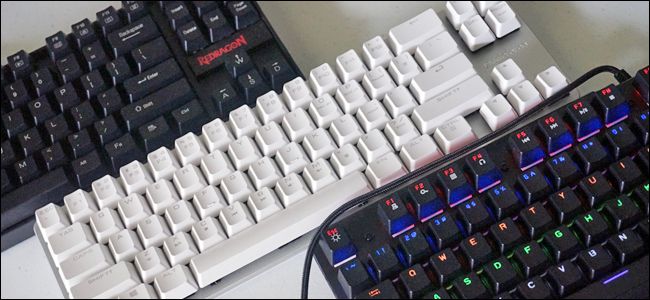
Mechanical keyboards are all the rage computer enthusiasts and gamers. If you’ve been using a rubber dome or scissor switch keyboard for your whole life, buying a new clicky keyboard might be intimidating, to say nothing of the considerable expense. Even the cheapest models from mainstream suppliers start at around $80, and go well into the hundreds for RGB lights and programmable extras—a lot of dough to drop on something you aren’t sure you’ll like.
To that end, we’ve gathered a collection of dirt-cheap mechanical keyboard picks. These all come from relatively unknown brands with cheaper components than most of the enthusiast models, but they’ll give you a good place to start if you want to investigate the wider world of mechanical keyboards. Best of all, they’re each $40 or less, so trying them out won’t cost you much more than a standard keyboard.
Why These Keyboards Are So Cheap
First, let’s temper your expectations just a little bit. These are, obviously, not as high quality as some more expensive keyboards—but we were surprised at how good they were. Some of it has to do with general build quality, but a big factor is the switches inside.
The individual key switches are what make mechanical keyboards unique: their complex spring-and-slider construction gives the keys a much longer, more satisfying “feel” than rubber dome keyboards, which is why they’re so coveted by typists and gamers. German corporation Cherry has been manufacturing its patented MX switches for over 30 years, and while they’re not the only switches that can be found in mechanical keyboards, they are the de facto standard.
Since the patent on Cherry MX switches expired, competitors have made “clone” switches that are generally sold to keyboard manufacturers for much less.
These switches have the same basic characteristics as Cherry MX switches, including cross-shaped stems that are compatible with the same keycaps, and different colors corresponding to different switch types. The main difference: these clone switches are mass manufactured in China with (presumably) less strict tolerances gives them a looser, more shaky feel than the genuine article. That said, they’re very much preferred by bargain-hunters, since real Cherry MX switches or equivalents cost about a dollar per switch, instantly putting keyboards outside the range of an impulse purchase.In addition, these keyboards tend to lack more advanced features like programmable RGB backlighting (or backlighting at all, in some cases), detachable USB cables, and other niceties like that. You may find one of those features occasionally, but you’ll rarely find them all on one board.
Cherry MX switches come in different colors, each coded to quickly explain different variables of the switch itself: the strength of the spring, the “bump” or lack thereof at the point where a stroke is registered, and whether the key makes an audible “click” as it’s pressed. Other manufacturers have copied the color coordination scheme along with the Cherry MX switch design, so we’ve broken the recommendations below along those lines.
If a lot of that mechanical keyboard jargon sounds like another language to you, check out our explainer on all the different mechanical keyboard terms.
The Best Cheap Keyboard With “Blue” Switches: Redragon K552-M KUMARA
Blue switches are generally preferred by typists, thanks to a low actuation force and a loud “click” with each press of the key. It’s odd, then, that the Redragon board ($30) is explicitly aimed at “gamers,” who tend to prefer a linear switch for rapid key presses (see below). Nevertheless, this model is one of the cheapest on the market at just $30. More expensive models can be had with different flavors of LED lighting, but they’re all equipped with the same blue clicky switch. (The Amazon listing for the Redragon says that it uses “Cherry MX Green equivalent” key switches, but this appears to be a mistake—they’re definitely Blue clones.)
The switches themselves come from a company called Outemu, a common supplier of “clone” switches. Though the stems are a tiny bit more loose with a stiffer central spring than standard Cherry MX Blues, they give an acceptable approximation. The tenkeyless (also known as “TKL”) layout is plenty for most users who don’t do rapid data entry, but there’s also a full-size version with a number pad called the Redragon VARA ($40) for those who prefer it. Standard key sizes mean that aftermarket keycaps can be installed. The Redragon comes with a free plastic keycap tool for pulling them off, but the USB cable is fixed in place.
The board seems to have a bit of metal in the case (if not a full metal plate), which is something of a luxury at this price point, and gives it more heft and stability than other budget keyboards. The keycaps aren’t especially attractive, with standard ABS plastic and stamped legends that will wear down fast under constant typing. The case has a significant lip at the edges, which will make it harder to clean, but the Cherry-style stabilizers will save some headaches when swapping out longer keycaps. The Redragon board can be had with rainbow, all-red, or multicolor RGB lights for a bit more cash.
If you don’t like the look of the Redragon, you have a few other options with blue switches:
- This Eagletec model ($40) is a bit larger, has a full metal plate, and (for a few…
The post The Best Cheap Mechanical Keyboards Under $40 appeared first on FeedBox.